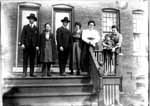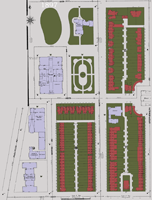The Pullman Militia
You are at Home -> The People of Pullman -> The Pullman MilitiaThe Pullman Militia
During George Pullman's time, the United States had a very small standing army (perhaps 100,000 men) and would rely on locally raised militias and troop levies to fill the ranks. It was considered the height of civic responsibility to raise and train a reserve unit in one's town. Naturally, Pullman, the perfect town, had to have its own militia. The first Market Hall (which burned down in 1892) was designed from the outset as an armory. According to the Chicago Tribune, May 17, 1882: The new market is nearly ready for occupation. The ground floor will be entirely devoted to the sale of meats, vegetables, etc. On the floor above is a hall capable of seating 300 people. This will be used as an armory by the military organization to be formed in Pullman. The Chicago Times, June 9, 1882: Steps are being taken to form a military company at Pullman. The market hall was built especially for an armory, and is excellently adapted to this purpose.
The company was actually formed shortly thereafter according to the Chicago Times, Nov. 15, 1882: A military company has been organized at Pullman to be known as Company G, 2nd Regiment, Illinois National Guard. The officers are: James A. Price, Captain; William Swart, 1st Lieutenant; S.H. McNalib, 2nd Lieutenant. The organization has 45 members, and it is expected that the number will be considerably increased.
It is not clear when the company was disbanded; however, there is an oblique mention of the militia company in an article about the strike. On July 8, 1894, the Tribune reported that yesterday the fact was made known also that the Deputy Marshals were searching Pullman and Kensington for a lot of guns, purchased some years ago from the city by an independent company of militia which has since been abandoned. There were 300 of the weapons, the old pattern in use at the time of the 'Haymarket Riots.' Therefore, some time between 1883 and 1894, the militia was disbanded.
THE PULLMAN HISTORY SITE

More Information About the People of Pullman
The People of Pullman
The Pullman House History Project
Maps of Pullman
Images of Pullman People
Images of Pullman people
Other Pullman-Related Sites
- Historic Pullman Garden Club - An all-volunteer group that are the current stewards of many of the public green spaces in Pullman. (http://www.hpgc.org/
- Historic Pullman Foundation - The HPF is a non-profit organization whose mission is to "facilitate the preservation and restoration of original structures within the Town of Pullman and to promote public awareness of the significance of Pullman as one of the nation's first planned industrial communities, now a designated City of Chicago, State of Illinois and National landmark district." (http://www.pullmanil.org/)
- The National A. Philip Randolph Pullman Porter Museum is a 501(c)3 cultural institution. Its purpose is to honor, preserving present and interpreting the legacy of A. Philip Randolph, Pullman Porters, the Brotherhood of Sleeping Car Porters and the contributions made by African-Americans to America's labor movement. ((http://www.nationalpullmanportermuseum.com/)
- Pullman Civic Organization - The PCO is a strong and vibrant Community Organization that has been in existence since 1960. (http://www.pullmancivic.org/)
- Pullman National Monument - The official page of the Pullman National Park. (https://www.nps.gov/pull/)
- South Suburban Genealogical & Historical Society - SSG&HS holds the Pullman Collection, consisting of personnel records from Pullman Car Works circa 1900-1949. There are approximately 200,000 individuals represented in the collection. (https://ssghs.org/)
- The Industrial Heritage Archives of Chicago's Calumet Region is an online museum of images that commemorates and celebrates the historic industries and workers of the region, made possible by a Library Services and Technology Act grant administered by the Illinois State Library. (http://www.pullman-museum.org/ihaccr/)
- Illinois Digital Archives (IDA) is a repository for the digital collections libraries and cultural institutions in the State of Illinois and the hosting service for the online images on this site. (http://www.idaillinois.org/)



